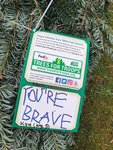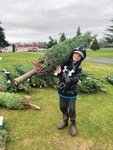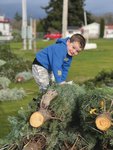




.jpg)



For Pacific Northwest Christmas tree growers, the season of giving is more than just about bringing cheer to their customers. It’s also about giving the gift of holiday memories to those who need it.
And it’s a time when relationships are forged and strengthened through the donation of these farmers’ crops — “the best product in the world,” says Rochester grower Mark Steelhammer — a real Christmas tree.
Steelhammer and his wife, Luanne, have managed the Washington collection of Trees for Troops for the last few years at their business, KLM Tree Farm.
This national program, which gathers Christmas tree donations and distributes them to military bases across the U.S., has been around for 16 years.
“It’s worth it,” said Mark Steelhammer, whose farm donated half of the 350 Washington trees sent to troops this year. “We think it’s important because those troops put their lives on the line for us, and this is a way to show them we appreciate that.”
Local children write messages to the troops on tags that are attached to the trees. This is a way for the kids to give back as well and to understand, maybe for the first time in their young lives, that although the U.S. might not be in any highly publicized conflicts today, men and women are still risking their lives to protect people here, the longtime tree grower said.
In Oregon, Jim Heater, who is “semi-retired” from the family’s Silver Mountain tree farm near Salem, has been a strong advocate for Trees for Troops. One year he went with a shipment of trees donated to Marine Corps Base Camp Pendleton, near Santa Barbara, California.
“People there were so appreciative,” Heater said. “There were mothers with their kids whose husbands were overseas. They were so thankful to receive the trees. When an industry can give back, it’s a great thing.”
Growers Kenny and JoAnn Scholz and their family, who operate Snowshoe Evergreen tree farm in Orting have been longtime contributors to Trees for Troops. This year they sent 100 trees.
They, along with many in their industry, also donate trees and greenery for garlands and wreaths to local charity groups and other associations such as FFA.
“We have to be willing to give back to our community,” Kenny Scholz said.
And it’s critical that growers send trees and greenery to places like Northwest state buildings, where lawmakers will craft legislation that impact these farmers and their industry, he said.
The Scholz family, for example, sent hand-crafted wreaths to leaders of the Washington legislature, the Washington Department of Agriculture, and other public and private industry partners on behalf of the industry.
And strengthening relationships through these holiday donations is also important for Christmas tree research.
Members of the Pacific Northwest Christmas Tree Association send trees and greenery to Washington State University and Oregon State University, where researchers and extension agents are vital to the continued success of growers, Scholz said.
“We growers have to put some skin in the game,” he said. “Budgets at these universities are tight, and it gets harder and harder to get funding for some of these projects that ultimately help our industry.”
He is worried that as OSU and WSU lose researchers and experience shrinking budgets, Christmas tree growers will be “left in the dark.”
“It’s not if but when that a disease will come along that keeps us from shipping trees,” he said. “I can see a catastrophic end to this if we don’t continue to get support for these folks.”
It’s researchers such as Chal Landgren, a mostly retired Christmas tree specialist with the OSU North Willamette Research and Extension Center, and Gary Chastagner, professor of plant pathology with the WSU Research and Extension Center, who have helped the industry through many tough fights.
Swiss needle cast, many years ago, set fear into the hearts of many growers. The fungus native to the Pacific Northwest caused many Douglas fir trees to lose their needles. Chastagner has also worked on the issue of root rot, a fungal disease that can shrink plantation yields by up to 75%.
“Gary has been able to help solve many problems not only for Christmas tree growers but also for forestry,” Scholz said.
Landgren, who specialized in Christmas trees and conducted research for decades in the Pacific Northwest, said the relationship with growers is essential.
“Almost all our plots for experimentation have been on growers’ farms,” he said.
Hundreds of plots carved out of growers’ fields have yielded results — good and bad — over the years, Landgren said.
“Growers have been very forgiving,” he said, recounting how sometimes the testing doesn’t work, and farmers lose the trees in the plot. “But we always learn something.”
He has been involved in projects working to control slugs on trees. Asking, for example, if a grower wants to use a water bath to get rid of the pests, what temperature does the water need to be, and how long does the tree need to be under water? And he’s worked on projects like seedling survival.
“Lots of our ideas for experiments come from the growers themselves,” Landgren said. “And in some cases, we’re testing what growers are already doing.”
One of many ways growers show their appreciation for this work each year is during harvest, when they can donate some of their products to these research groups.
This year, for example, Bryan Brown, owner of Westwinds Farms and Nursery in Dallas, Oregon, and several partners donated a giant, 30-foot Nordmann fir Christmas tree to bring holiday cheer to OSU’s Peavy Forest Science Center in Corvallis.
The 18-year-old tree came from genetically improved seed from the Ken Brown Seed Orchard, named for Bryan Brown’s enterprising father. The seed orchard is part of an on-going research project with OSU to work on improving needle quality and retention and enhancing the growth of trees in the Willamette Valley.
“The tree donation helps highlight the 30 years of work that has gone into tree breeding between growers and OSU,” Landgren said. “This big tree in the lobby reinforces the importance of that relationship with growers and is a representation of that cooperation.”
For Bryan Brown, the gift was particularly critical at a time when OSU is making decisions about replacing Landgren, who is retired but still working part time.
“We wanted to make sure this went to a good home and was a way to connect with the people making a decision about Chal’s replacement,” Brown said.
“It was a hit,” he said. “And we were really happy to see this beautiful tree go to a good home.”